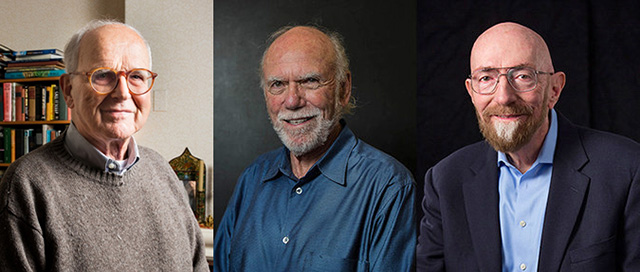Nobel Prize in Physics 2017 Goes to Weiss, Barish & Thorne

Richard Fienberg Running Hare Observatory
This announcement is adapted in part from a Royal Swedish Academy of Sciences press release:
The Royal Swedish Academy of Sciences has awarded the Nobel Prize in Physics 2017 with one half to AAS member Rainer Weiss (MIT) and the other half jointly to Barry C. Barish and AAS member Kip S. Thorne (both Caltech) "for decisive contributions to the LIGO detector and the observation of gravitational waves." The prize includes an honorarium of 9 million Swedish krona, or about USD $1.1 million.
L to R: Rai Weiss (MIT/M. Scott Brauer), Barry Barish (Caltech) & Kip Thorne (Caltech)
Gravitational Waves Finally Captured
On 14 September 2015, the universe's gravitational waves were observed for the very first time. The waves, which were predicted by Albert Einstein 100 years ago, came from a collision between two black holes. It took 1.3 billion years for the waves to arrive at the LIGO detector in the USA.
The signal was extremely weak when it reached Earth, but is already promising a revolution in astrophysics. Gravitational waves are an entirely new way of observing the most violent events in space and testing the limits of our knowledge.
LIGO, the Laser Interferometer Gravitational-Wave Observatory, is a collaborative project with more than 1,000 researchers from more than 20 countries. Together, they have realised a vision that is almost 50 years old. The 2017 Nobel Laureates have, with their enthusiasm and determination, each been invaluable to the success of LIGO. Pioneers Rainer Weiss and Kip S. Thorne, together with Barry C. Barish, the scientist and leader who brought the project to completion, ensured that four decades of effort led to gravitational waves finally being observed.
In the mid-1970s, Rainer Weiss had already analysed possible sources of background noise that would disturb measurements, and had also designed a detector, a laser-based interferometer, which would overcome this noise. Early on, both Kip Thorne and Rainer Weiss were firmly convinced that gravitational waves could be detected and bring about a revolution in our knowledge of the universe.
Gravitational waves spread at the speed of light, filling the universe, as Albert Einstein described in his general theory of relativity. They are always created when a mass accelerates, like when an ice-skater pirouettes or a pair of black holes revolve around each other. Einstein was convinced it would never be possible to measure them. The LIGO project's achievement was using a pair of gigantic laser interferometers to measure a change thousands of times smaller than an atomic nucleus, as the gravitational wave passed through Earth.
So far all sorts of electromagnetic radiation and particles have been used to explore the universe. However, gravitational waves are direct testimony to disruptions in spacetime itself. This is something completely new and different, opening up unseen worlds. A wealth of discoveries awaits those who succeed in capturing the waves and interpreting their messages.
President Christine Jones, Executive Officer Kevin Marvel, and all the other leadership and staff of the AAS heartily congratulate Rai Weiss, Barry Barish, and Kip Thorne — as well as the entire LIGO Scientific Collaboration — for the 2017 Nobel Prize in Physics!


